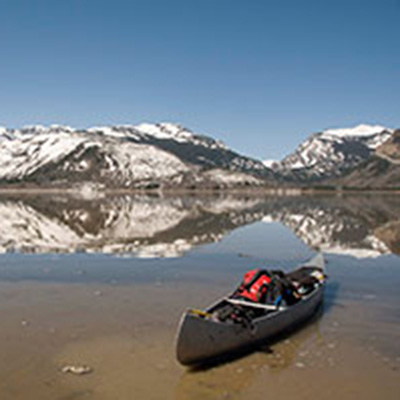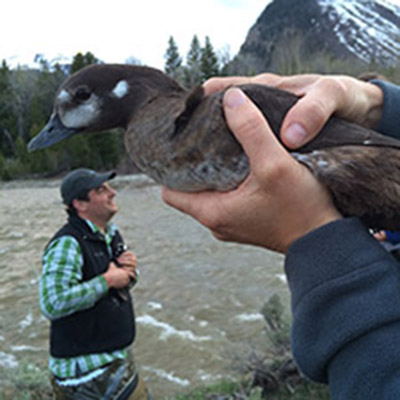Wyoming Harlequin Duck Conservation Studies
Wyoming supports approximately 70 pairs of breeding Harlequin Ducks (Histrionicus histrionicus) which are a designated “Species of Greatest Conservation Need” (Wyoming State Wildlife Action Plan 2017). In order to conserve Wyoming’s Harlequin Duck population, the species’ year-round habitat requirements, general breeding ecology, and migration patterns must be better understood. The Wyoming State Wildlife Action Plan (2017) identified the need for information on Harlequin Duck movements in Wyoming, and in coordination with other states.
See videos below for more information on (1) Harlequin Duck migration and (2) transmitter use
Project Goals

The Harlequin Duck is a designated “Species of Greatest Conservation Need” (Wyoming State Wildlife Action Plan 2017), yet little information is available on survivorship, migration movements, and winter habitat use areas. These data are needed to manage for the long-term viability of this species in Wyoming. Our initial project goals were to conduct an on-site visit to harlequin breeding streams in Wyoming, to begin color banding individuals, and to assess the location for a continued harlequin population monitoring study site.
Project Components

The breeding habitat requirements and historical occupancy in breeding streams are well documented for many Rocky Mountain populations of Harlequin Ducks in the US and Canada. In Wyoming, Harlequin Ducks breed exclusively among mountain streams in the northwestern portion of the state, with significant concentrations in Grand Teton and Yellowstone National Parks, and in the Teton Wilderness on the Bridger-Teton and Shoshone National Forests. Harlequin Ducks breeding in the western U.S. and Canada migrate to the Pacific coastline for the winter. However, the specific migration routes, timing, and habitat types used during post-breeding activities (i.e., molting, staging, and migration) are much less understood for most western U.S. breeding harlequins.
In an effort to address these knowledge gaps, we performed a Harlequin Duck migration study in Wyoming during 2016-2018. In spring, wildlife biologists and veterinarians from the US and Canada visited harlequin breeding streams to capture pairs and attach cutting edge tracking technology in order to track the migrations and seasonal movements of breeding Harlequin Ducks. The male harlequins were equipped with a specialized implantable satellite transmitter, while a small geolocator tracking device was attached the to the leg bands of the females. In addition to Wyoming, collaborators tagged pairs of breeding Harlequin Ducks in Montana, Washington, and Alberta, Canada.
Project Updates

In Wyoming during 2016-2018, we tracked the seasonal movements of nine male Harlequin Ducks captured and marked with satellite transmitters on breeding streams or spring staging locations within Grand Teton National Park and Yellowstone National Park. All nine harlequins successfully initiated molt migration toward the Pacific coast. Male harlequins departed their breeding areas during the early portions of June through early July (June 3 – July 8).

The duration of molt migration from breeding sites to their Pacific coast molting areas ranged from ≤4 to 38 days. Male harlequins tended to utilize rivers as stopover locations during migration. Harlequins migrated through a wide variety of habitats, with a preference for temperate conifer forests. Three individuals also utilized grasslands, deserts, and shrublands during migration

We identified the molting locations of seven male harlequins, which included the western coastline of Vancouver Island (n=5), the Salish Sea/Puget Sound (n=1), and coastal Oregon (n=1). Male harlequins generally remained at or near their molting sites during the winter season. One male was successfully tracked for its complete annual cycle.


